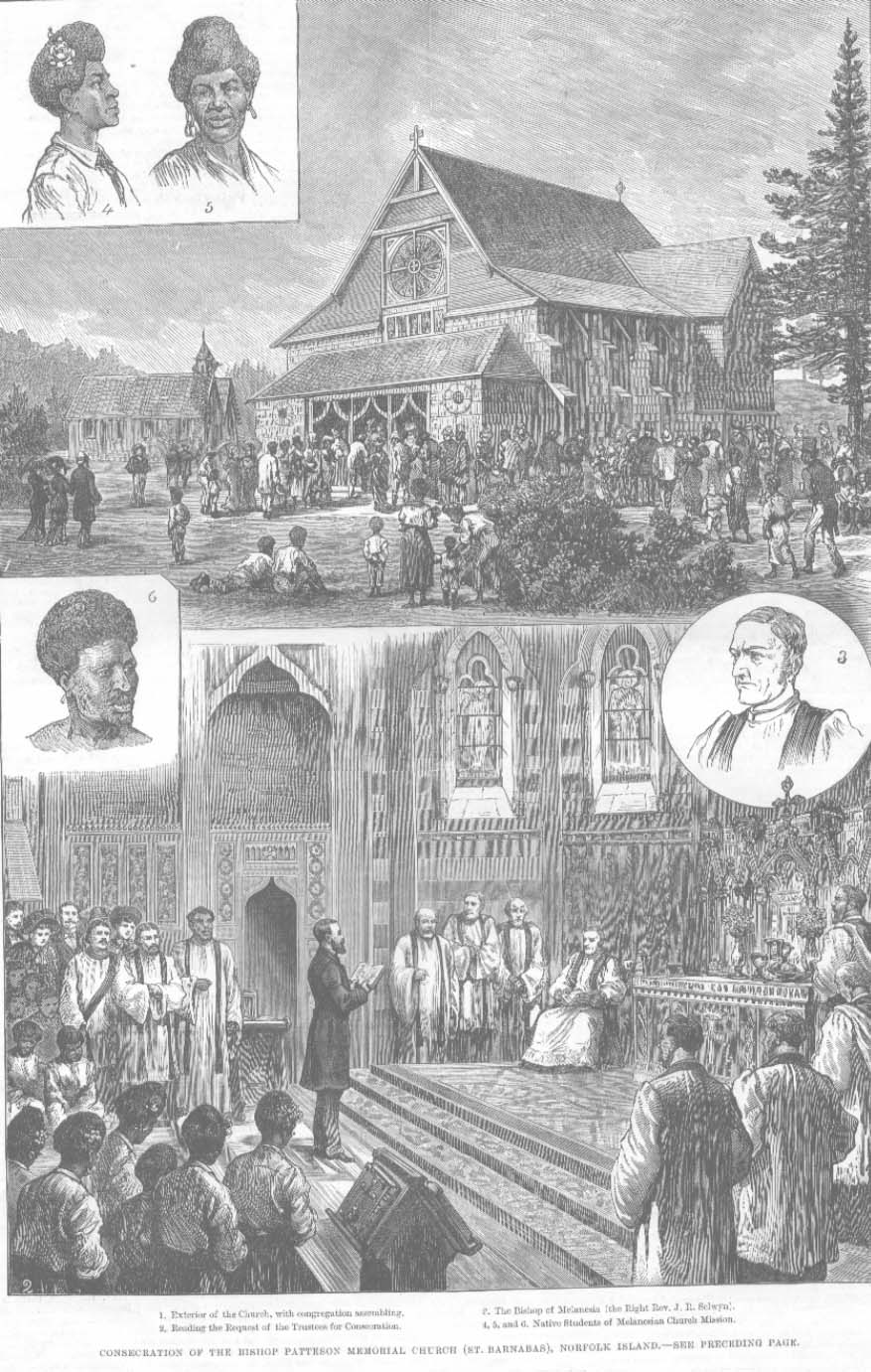
- Exterior of the Church, with congregation assembling
- Reading the Request of the Trustees for Consecration
- The Bishop of Melaneria (the Right Rev. J. R. Selwyn).
- Native Students of Melanesian Church Mission
Consecration of the Bishop Patteson Memorial Church (St. Barnabas), Norfolk Island
The lamented death, in 1871, of John Coleridge Patteson, Bishop of the Missionary Diocese of Melanesia, is a striking incident of the history of religious and philanthropic enterprise. He was cruelly slain, probably under a mistaken impression of the object of his visit, by the savage natives of Santa Cruz, one of the small islands in the Western Pacific Ocean, belonging to what, is called the Melanesian group, a name derived from the blackish colour of its population, who are of the Papuan negroid race. He had been appointed first Bishop of Melanesia, a diocese created by the efforts of the late Bishop of New Zealand, the Right Rev. Dr. Selwyn. afterwards Bishop of Lichfield. A son of that eminent prelate is John Richardson Selwyn, who now holds the Melanesian Bishopric. This Episcopal See, with the head-quarters of the mission, is fixed, at Norfolk island, where a church has lately been erected, and dedicated to St. Barnabas, which will serve both as a memorial of Bishop Patteson and as a collegiate chapel. It is externally not a very imposing edifice; the walls are chiefly built of coarse native sandstone, but the upper part of these walls, on two sides, has been constructed of wood, and they are only 17 ft. high; while the west front and porch have no pretensions to beauty. The interior, however, is described as having a considerable degree of elegance and dignity; the inner walls are of white hewn stone, laid in alternate courses, which has a very good effect; while the high-pitched open roof, of Norfolk Island pine with Kauri planking, rises to a fair elevation. The nave is 54 ft. long by 27 ft. 6 in. wide; there are two small transepts, used as a vestry and organ-chamber; and an apsidal chancel, 24ft. wide, which is beautifully decorated. The steps to the chancel are of black Devonshire marble, and it is paved with marble of two colours in an ornamental pattern. The reredos, of black walnut, with mosaic panels, the five pointed windows of stained glass, representing Christ and the four Evangelists, the fine organ, the font, and other furniture of this church, are handsome accessories to the building.
We present a page of Sketches, by the Rev. Philip Walsh, showing the church, outside and inside, with the clergy and congregation assembled on Dec. 7. for the consecration service. Amongst these were Bishop J. R. Selwyn. of Melanesia; Bishop Stuart, of Waiapu, New Zealand; archdeacon Maunsell, of Waitemata; the Rev. G. H. Nobbs, Colonial chaplain, the Rev. Dr. Kinder, and some other clergymen: Mr. Mills, M.P. for Exeter; Lieutenant Mills, R. E., and many other visitors, besides the members and native scholars of the Melanesian Mission. The Bishop of Melanesia having taken his seat, Mr. J. R. Upton, trustee of the Mission property, advanced to the chancel steps, and read a request that the church might be consecrated. The Bishop having read his consent, the clergy marched round the interior of the building, repeating the 115th Psalm, "Not unto us, O Lord, but to Thy Name give the praise." The consecration service, which was in the Mota language, was then proceeded with by Bishop Selwyn taking the principal part; after which, came the morning prayer and the communion service. The sermon, from the text, Isaiah liii. 2, was preached by the Rev. B. T. Dudley, Incumbent of St. Sepulchre's, Auckland, formerly some years with the Mission. At the end of the service a hymn was sung, which had been composed for the occasion.